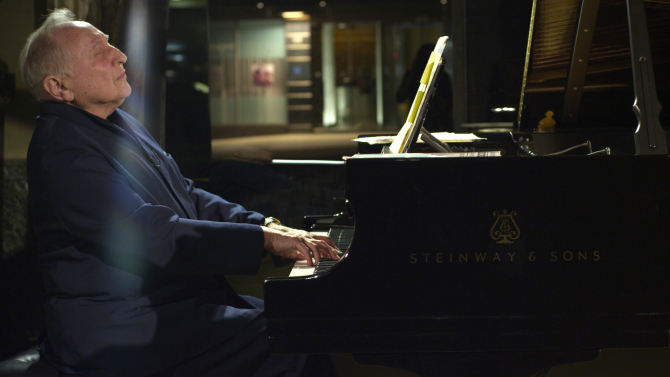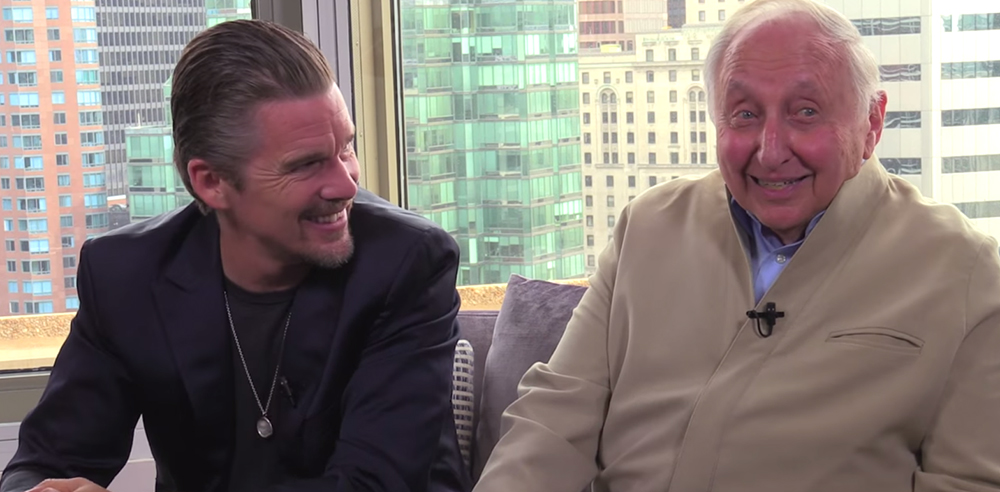
In Woody Allen’s film, The Purple Rose of Cairo, the heroine’s world is turned upside down when the matinée idol from the movie she is watching steps from the screen and enters her life. Recently I reversed Allen’s plot device by stepping into a film, when I travelled to New York City to have a piano lesson with Seymour Bernstein, the subject of a new documentary by Ethan Hawke: Seymour, An Introduction.
Anyone who attended the film’s premiere at last year’s Toronto International Film Festival, will recall both the pleasure of watching this portrait of a master piano teacher who voluntarily retired from the pinnacle of his concert career in favour of a saner life and the thrill of hearing Seymour speak in person about the significance of playing piano.
The topic that frames the film is stage fright, beginning with Bernstein’s conversation about it with a lifelong student, and ending with his first public performance in 35 years at Steinway Hall. Within this frame we move back and forth from Bernstein’s current life teaching students in his Steinway-crammed studio apartment in Manhattan to his studies with European luminaries including Nadia Boulanger and Sir Clifford Curzon, to his military service in Korea. Scenes of Seymour teaching several of his students reveal the richness of the relationships he has developed with them.
The culminating scene, in which, at age 85 , Seymour meets the challenge of public performance after 35 years, is utterly uplifting. It proves that there is always hope of fulfilling one’s goals, no matter how long deferred, by dint of hard work and courage. As an amateur pianist who has returned to the keyboard after a 40-year hiatus, this is inspiring. As I listened to Seymour speak in person after the film, I realized that his wisdom on the mastery of the piano goes far beyond considerations of the artistic and technical challenges into the deeper philosophical questions of what constitutes the good life. His observations on the effect of practicing piano on the growth of the whole person crystallized an understanding of my own experience trying to retrieve my piano skills. A serious commitment to disciplined, painstaking piano practice results in much more than improved musical performance but personal integration and resilience. As a psychotherapist who learns about and reflects on human development and emotional healing, it was illuminating, but also humbling that I hadn’t recognized this myself.

Seymour’s message to the amateur pianist is empowering: it takes just as much skill to play well as an amateur as it does as a professional, and this justifies whatever time and other resources are required. “The engaged pianist is working on an intellectual, physical and emotional level,” Bernstein told the audience that night. “That is a powerful integration. Why leave it at the keyboard? You can take it into life.”
Before I heard Seymour Bernstein I thought that playing piano enhances life. Listening to him I realized that it can actually transform life.
Bernstein’s rich character, combining playfulness, sensitivity, authority and authenticity, plus the engagement shared between him and his students, created a genuine yearning in me to have a lesson with him. It wasn’t that I was discontented with the wonderful teachers I have had in the past, starting with my beloved childhood teacher, Miriam Russell Smith. It was just knowing that Seymour is a living person in non-virtual reality made the possibility of meeting him irresistible.
And so I was incredulous but delighted, late in January, to find myself inside the wonderful ambience of Bernstein’s Steinway-dominated studio apartment off Central Park West. The room, which is the main location of the film, has high ceilings, low lighting, windows from which the sound of the keyboard is heard on the street a short flight of steps below, and is optimally crowded with functions and artifacts so that its spatial size seems to expand into a cultural vault without physical limits.
Because Bernstein had been so consistently himself in the film, during the question period and throughout our correspondence, I was not worried that he would turn out to be different when we met. Indeed, he was just as I expected, warm, spontaneous, and open. What turned out to be slightly different from the film was me. The students in the film are advanced players; some who have worked with him for decades, developing advanced repertoires. Bernstein told me he loves teaching amateurs, but only when I put my hands on the same keys as his other students did it occur to me that I am probably far below their level of skill and aptitude. But by that point, the only thing to do was to get to work. At the keyboard Bernstein combined the precision of a surgeon, the no-nonsense command of a drill sergeant, the patience of a saint and the attentiveness of a good parent.
Putting me through multiple repetitions of the same two note slur in a Mozart sonata, identifying a different deficiency each time, he watched every minute motion, breaking it down in a variety of ways, until after countless attempts, I executed the phrase the way it should be done. Like a baby whose first fledgling first steps are facilitated because a parent is observing them, I was able to persist with the task because Bernstein knew how important it was to acquire this skill. “You see what’s involved in playing piano?” he asked me, sympathetically, when it took so many tries to finally get it. “If you want to be interpretive, this is what is necessary.”
At the end of The Purple Rose of Cairo, the heroine has nothing to show for her interlude with her celluloid paramour. I returned from New York with a video of my lesson, as well as Seymour’s notation of the fingering for a section of the Sonata, on my score. The hour and a half lesson will take many hours to absorb and even more hours of practice to integrate. Now that I am back at my own piano, the obvious fact that a single lesson is never a turning point in a person’s ability has sunk in. What matters is practice, properly understood, which is Bernstein’s main point in the first place.
+++
See below for a video interview about the film, Seymour, An Introduction, which premiere at TIFF in 2014.



